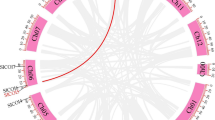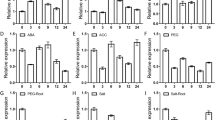Abstract
Key message
SlCRF1 and SlCRF2 are expressed throughout the plant, prominently in vascular tissue. Each SlCRF has a distinct pattern of cytokinin induction and regulation by abiotic stresses in different organs.
Abstract
Cytokinin is an essential plant hormone involved in the regulation of many growth and developmental processes. While many cytokinin signaling pathway components have been well characterized, the cytokinin response factors (CRFs) that form a branch of this pathway are less well understood. This study examines the tomato (Solanum lycopersicum (L.)) CRF genes, SlCRF1 and SlCRF2 presenting a detailed and novel characterization of their developmental expression patterns, transcriptional regulation by hormones particularly cytokinin, and response to abiotic stresses. Both SlCRF1 and SlCRF2 were predominantly expressed in vasculature in tissues throughout the plant, with an overall trend for greater SlCRF2 expression in younger organs. Hormone regulation of SlCRF1 and SlCRF2 transcripts is primarily by cytokinin, which induced both SlCRFs in different organs over a range of developmental stages. The strongest cytokinin induction was found in leaves, with SlCRF2 induced to a higher level than SlCRF1. Examination of SlCRF transcripts during abiotic stress responses revealed that SlCRF1 and SlCRF2 have distinct patterns of regulation from each other and between leaves and roots. Novel connections between SlCRFs and stresses were found in particular including a strong induction of SlCRF1 by cold stress and a strong induction of SlCRF2 by oxidative stress in roots and unique patterns of induction/repression linking both SlCRFs to drought stress and response during recovery. Overall, this study provides a clear picture of SlCRF1 and SlCRF2 expression patterns across tissues during development and in response to cytokinin and specific stresses, indicating their importance in plant growth and environmental responses.





Similar content being viewed by others
References
Apel K, Hirt H (2004) Reactive oxygen species: metabolism, oxidative stress, and signal transduction. Annu Rev Plant Biol 55:373–399
Compton MA (2012) Cytokinin Response Factor 4: a role in development during cold stress in Arabidopsis thaliana (thesis). Auburn University, Auburn
Cutcliffe JW, Hellmann E, Heyl A, Rashotte AM (2011) CRFs form protein–protein interactions among each other and with members of the cytokinin-signaling pathway in Arabidopsis via the CRF domain. J Exp Bot 62:4995–5002
Desikan R, Soheila AH, Hancock JT, Neill SJ (2001) Regulation of the Arabidopsis transcriptome by oxidative stress. Plant Physiol 127:159–172
Expósito–Rodríguez M, Borges AA, Borges-Pérez A, Pérez JA (2008) Selection of internal control genes for quantitative real-time RTPCR studies during tomato development process. BMC Plant Biol 8:131
Gu YQ, Wildermuth M, Chakravarthy S, Loh YT, Yang C, He X, Han Y, Martin G (2002) Tomato transcription Factors Pti4, Pti5, and Pti6 activate defence responses when expressed in Arabidopsis. Plant Cell 14:817–831
Jeon J, Kim J (2013) Arabidopsis response regulator 1 and Arabidopsis histidine phosphotransfer protein 2 (AHP2), AHP3, and AHP5 function in cold signaling. Plant Physiol 161:408–424
Karimi M, Inzé D, Depicker A (2002) Gateway vectors for Agrobacterium-mediated plant transformation. Trends Plant Sci 7:193–195
Mok DW, Mok MC (2001) Cytokinin metabolism and action. Annu Rev Plant Physiol Plant Mol Biol 89:89–118
Okazaki K, Kabeya Y, Suzuki K, Mori T, Ichikawa T, Matsui M, Nakanishi H, Miyagishima S (2009) The PLASTID DIVISION1 and 2 components of the chloroplast division machinery determine the rate of chloroplast division in land plant differentiation. Plant Cell 21:1769–1780
Park J, Park C-J, Lee S-B, Ham B-K, Shin R, Paek K-H (2001) Overexpression of the Tobacco Tsi1 gene encoding an EREBP/AP2-type transcription factor enhances resistance against pathogen attack and osmotic stress in Tobacco. Plant Cell 13:1035–1046
Rashotte AM, Goertzen LR (2010) The CRF domain defines cytokinin response factor proteins in plants. BMC Plant Biol 10:74–83
Rashotte AM, Mason MG, Hutchison CE, Ferreira FJ, Schaller GE, Kieber JJ (2006) A subset of Arabidopsis AP2 transcription factors mediates cytokinin responses in concert with a two-component pathway. Proc Natl Acad Sci USA 103:11081–11085
Schlereth A, Möller B, Liu W, Kientz M, Flipse J, Rademacher EH, Schmid M, Jürgens G, Weijers D (2010) MONOPTEROS controls embryonic root initiation by regulating a mobile transcription factor. Nature 464:913–916
Shi X, Gupta S, Rashotte AM (2012) Solanum lycopersicum cytokinin response factors (SlCRFs) genes: characterization of CRF domain containing genes in tomato. J Exp Bot 63:973–982
To JP, Kieber JJ (2008) Cytokinin signaling: two-components and more. Trends Plant Sci 13:85–92
Weigel D, Glazebrook J (2002) Arabidopsis: a laboratory manual. Cold Spring Harbor Laboratory Press, New York
Werner T, Schmülling T (2009) Cytokinin action in plant development. Curr Opin Plant Biol 12:527–538
Zhou J, Tang X, Martin G (1997) The Pto kinase conferring resistance to tomato bacterial speck disease interacts with proteins that bind a cis-element of pathogenesis-related genes. EMBO 16:3207–3218
Zhou J, Wang J, Shi K, Xia XJ, Zhou YH, Yu JQ (2012) Hydrogen peroxide is involved in the cold acclimation-induced chilling tolerance of tomato plants. Plant Physiol Biochem 60:141–149
Zwack PJ, Shi X, Robinson BR, Gupta S, Gerken DM, Compton MA, Goertzen LR, Rashotte AM (2012) Vascular expression and C-terminal sequence divergence of cytokinin response factors in flowering plants. Plant Cell Physiol 53:1683–1695
Zwack PJ, Robinson BR, Risley MG, Rashotte AM (2013) Cytokinin response factor 6 negatively regulates leaf senescence and is induced in response to cytokinin and numerous abiotic stresses. Plant Cell Physiol 54:971–981
Acknowledgments
We thank all Rashotte lab members for their help during this study. This work was funded by USDA-NRI Grant 2008-35304-04457 and AAES-HATCH Grant 370220-310007-2055.
Author information
Authors and Affiliations
Corresponding author
Additional information
Communicated by Z.-Y. Wang.
Electronic supplementary material
Below is the link to the electronic supplementary material.
Electronic supplementary material
299_2013_1510_MOESM1_ESM.tif
Online Resource 1 Microarray data for SlCRF1 expression from the tomato eFP browser at bar.utoronto.ca. The strong expression of SlCRF1 in leaves and unripe fruits supports the spatial expression of SlCRF1observed through SlCRF1 promoter::GUS reporter line analysis (TIFF 1259 kb)
299_2013_1510_MOESM2_ESM.tif
Online Resource 2 Microarray data for SlCRF2 expression from the tomato eFP browser at bar.utoronto.ca. The expression of SlCRF2 in leaves and roots supports the spatial expression of SlCRF2 observed through SlCRF2 promoter::GUS reporter line analysis (TIFF 1247 kb)
Rights and permissions
About this article
Cite this article
Shi, X., Gupta, S. & Rashotte, A.M. Characterization of two tomato AP2/ERF genes, SlCRF1 and SlCRF2 in hormone and stress responses. Plant Cell Rep 33, 35–45 (2014). https://doi.org/10.1007/s00299-013-1510-6
Received:
Revised:
Accepted:
Published:
Issue Date:
DOI: https://doi.org/10.1007/s00299-013-1510-6




